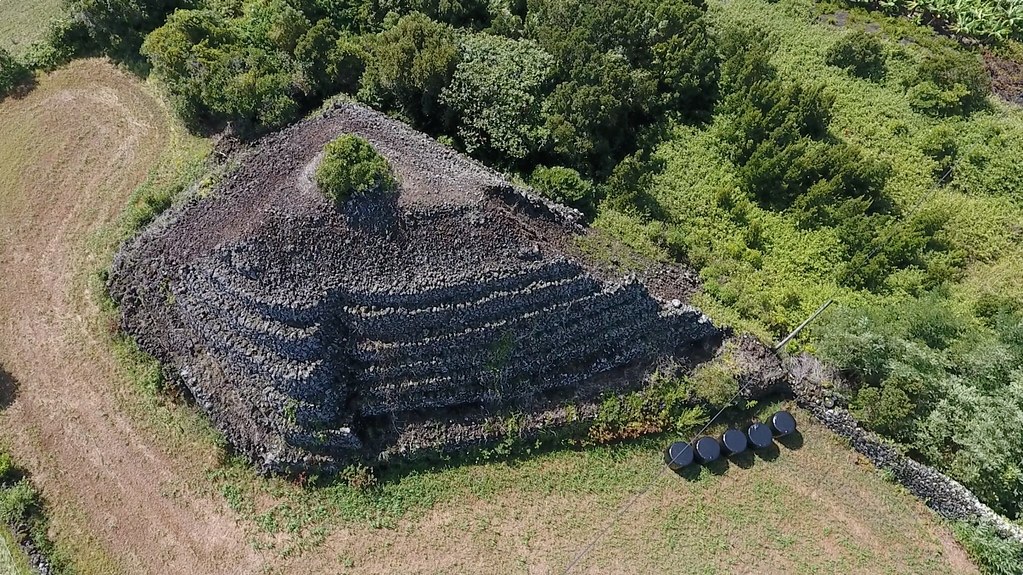The Azores Pyramids, also known as the Pyramids of the Azores or the Portuguese Pyramids, are a series of stone formations found on the Azores Islands. These structures have sparked interest and debate among archaeologists, historians, and enthusiasts. The Azores, an archipelago in the mid-Atlantic, are an autonomous region of Portugal. The discovery of these pyramidal structures has led to various theories about their origin and purpose, ranging from natural formations to remnants of ancient civilizations.
Get your dose of History via Email
Historical Background of the Azores Pyramids
The Azores Pyramids came into the spotlight when they were discovered in the 19th century. Portuguese soldiers stationed on the islands found them. However, it wasn’t until the 21st century that they gained significant attention. The structures are stone formations resembling pyramids, found on several islands of the Azores. Their origins are shrouded in mystery, with no clear consensus on who built them.
Some suggest that the pyramids were constructed by the Phoenicians, Carthaginians, or even the ancient Greeks. Others believe they may have been the work of early Portuguese settlers. There is also a theory that they could be natural formations, misinterpreted as man-made. Despite these theories, there is no concrete evidence to conclusively determine their creators.
There is no record of the pyramids being inhabited or used for any significant historical events. However, their presence on the islands has become an important part of local lore and culture. The Azores Pyramids are not widely known outside of Portugal, but they have become a point of interest for those who study prehistoric Europe and ancient seafaring civilizations.
The pyramids have not been the scene of any historically important events that are recognized by mainstream history. However, their existence has sparked curiosity and led to various expeditions to study them further. The lack of historical records makes it difficult to ascertain their significance in the past.
Overall, the Azores Pyramids remain an enigmatic feature of the islands. Their true history and purpose continue to elude experts, making them a fascinating subject for further research and exploration.
About the Azores Pyramids
The Azores Pyramids are stone structures that vary in size and complexity. Some are simple, small rock piles, while others are larger and more pyramid-like in shape. The materials used in their construction are primarily local volcanic rock, which is abundant on the islands. This has led some to believe that they may be natural formations.
The construction methods of the pyramids, if they are indeed man-made, are not well understood. There is no evidence of mortar or other binding agents, suggesting that they may have been built using dry stone techniques. This method involves stacking stones without any adhesive, relying on gravity and the shape of the stones to maintain the structure’s integrity.
Architectural highlights of the pyramids include their geometric precision and alignment. Some of the pyramids are aligned with astronomical events, such as solstices and equinoxes. This has led to speculation that they may have served a ceremonial or calendrical purpose.
The building materials and construction techniques suggest that the pyramids, if man-made, could date back to a prehistoric time when advanced tools were not available. However, without concrete evidence, it is difficult to determine the exact methods used in their construction.
The Azores Pyramids are not as grand or well-known as other pyramid structures around the world, such as those in Egypt or Mesoamerica. Nevertheless, they offer a unique glimpse into the potential history and culture of the Azores Islands and their inhabitants.
Theories and Interpretations
Several theories have been proposed regarding the Azores Pyramids. One theory suggests that they are the remnants of an ancient civilization that had navigational knowledge of the Atlantic. This civilization could have used the pyramids as landmarks or for astronomical purposes.
Another theory posits that the pyramids are natural formations, a result of the volcanic activity that formed the islands. Proponents of this theory argue that the geometric shapes could have been naturally occurring or the result of agricultural practices by early settlers.
Some interpretations of the pyramids link them to known historical cultures, such as the Phoenicians or Carthaginians, who were known for their seafaring capabilities. These cultures could have reached the Azores and constructed the pyramids as part of their explorations.
Dating the pyramids has been challenging due to the lack of organic material that can be analyzed using radiocarbon dating. However, some researchers have attempted to date the structures by examining the soil layers and erosion patterns around them.
The mystery surrounding the Azores Pyramids has led to a mix of scholarly research and speculative theories. The lack of definitive evidence means that the true nature and purpose of the pyramids remain open to interpretation.
At a glance
Country: Portugal
Civilization: Unknown, possibly Phoenicians, Carthaginians, ancient Greeks, or early Portuguese settlers
Age: Indeterminate, potentially prehistoric
Conclusion and Sources
Reputable sources used in the creation of this article include:
- Wikipedia: https://en.wikipedia.org/wiki/Azores

